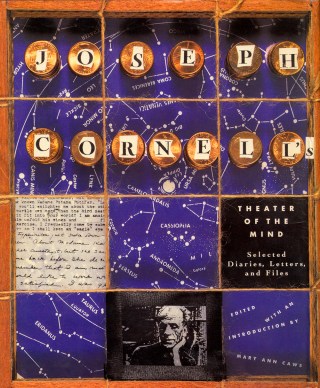Perspectival awakenings in the “blue dome, silhouetted city sky-line fringing it, and the gradual appearance of all the stars in the night sky to music.”
In the spring of 1919, as the world was shaking off the debris and despair of its first global war, the queer Quaker astronomer Arthur Eddington left England to traverse seas and meridians and blood-stained borders in an ambitious expedition to observe a total solar eclipse in order to prove correct, at the risk of his own reputation, the controversial theory of a ridiculed German Jew. Eddington’s historic observation of totality confirmed his instinct, confirmed relativity, catapulted Einstein into global celebrity, revolutionized our understanding of the universe, and united war-torn humanity under the same sky of elemental, astonishing truth.
But however much the telescopic perspective might lavish us with self-transcendence, it is only a temporary transcendence — the human animal is not marrowed and tendoned to roam the vast vistas of universal truth for too long before growing paralyzed again by its invented parochial partialities.

Within a generation, as the world was being savaged anew by its most bloodthirsty war yet, the artist Joseph Cornell (December 24, 1903–December 29, 1972) leaned on the cosmic perspective for a different kind of coherence, infusing astronomy into his visionary shadow boxes: reliquaries of the mundane washed up on the shoreline between memory and dream, discarded fragments of this world assembled into portals to another — a world of our world, yet more magical, more mystical, more immortal in its obsolescence.

On a warm and clear summer Tuesday in 1941, as WWII is rendering the present unbearable and the future uncertain, Cornell voyages first into the human past and then into the remote consolations of spacetime in a journal entry included in the out-of-print treasure Joseph Cornell’s Theater of the Mind: Selected Diaries, Letters, and Files (public library):
A suggestion of that wonderful feeling of detachment that comes over me every so often — a leisurely kind of feeling that seems to impart to the routine events of the day a certain sense of “festivity.”
[…]
Into the city and all the way up to the Museum of the American Indian to find it closed! Compensation in the buoyant feeling aroused by the buildings of the Geographic Society in their quiet uptown setting. An abstract feeling of geography and voyaging I have thought about before of getting into objects, like the Compass Set with map. A reminder of earliest school-book days when the world was divided up into irregular masses of bright colors, with vignettes of the pictorial world scattered, like toy picture-blocks.
To recompense the failed Native American art field trip, Cornell decides to head to the Museum of Natural History and forage for inspiration there. In a burst of spontaneity, after hours of copying Native designs into his sketchbook beneath an old oil painting of “an Indian princess” at the museum library, he decides to make his first visit to the museum’s now-iconic Hayden Planetarium, then just a few years old.

Not yet aware of how that extemporaneous encounter would foment the future of his art — as we rarely are of our most catalytic inspirations the moment we encounter them i the wild — Cornell writes:
The Planetarium was another moving experience, especially on the second floor with its blue dome, silhouetted city sky-line fringing it, and the gradual appearance of all the stars in the night sky to music.
He finds himself tuning out the bland educational lecture — “there is enough reconstruction of the night atmosphere and really so well done, to offset it” — and lets his imagination voyage into the celestial splendor. In a deeply pleasing parenthetical wink, penned long before the world had awakened to Hedy Lamarr’s contribution to science, he adds:
(Yesterday I was trying to fit Hedy Lamarr into Dante Gabriel Rossetti’s pre-Raphaelite garden, without success. She was more at-one today with the night sky of the Planetarium. I wish she could have done the lecturing, with her wonderful detachment.)
Upon returning to Earth, he immediately moors the conceptual quickening of the cosmos to the empirical materiality of his art, already foraging for objects at the museum that would invoke the feeling-tone of the celestial spectacle, already constellating those objects into shadow-boxed poems in his mind’s eye to invite the same transcendent cosmic perspective:
The astronomical paraphernalia: charts, transparencies, broken meteors, and especially compass curios (also armillaries, telescopes, etc.) are intriguing. Arranged in cases in the hall around the circular hall. On the amid floor a particularly fine set of murals of the zodiac, picked out in white on blue. The nicest rendition of the Gemini I’ve seen.

Although the night sky had fascinated Cornell since childhood, it was this visit to the planetarium that made astronomy a centerpiece of his art for the remaining three decades of his life, both as an object-category to for his boxes and as a sensemaking framework for the miniature cosmogonies of meaning nested inside them.

Nearly a century later, in another uncertain present amid another moment of cultural tumult, the endeavor to build New York City’s first public observatory emerged from the kindred sense that we may never know what child might step into the dome of possibility to become the next Eddington, what young artist might grow bewitched by the science and splendor of the cosmos through the telescope to become the next Cornell, or how many generations of human eyes and minds might look through the telescope to transcend the smallness of perspective that makes us draw imaginary lines of unbelonging beneath this boundless shared sky.
donating = loving
Bringing you (ad-free) Brain Pickings takes me hundreds of hours each month. If you find any joy and stimulation here, please consider becoming a Supporting Member with a recurring monthly donation of your choosing, between a cup of tea and a good dinner.
newsletter
Brain Pickings has a free weekly newsletter. It comes out on Sundays and offers the week’s most unmissable reads. Here’s what to expect. Like? Sign up.





